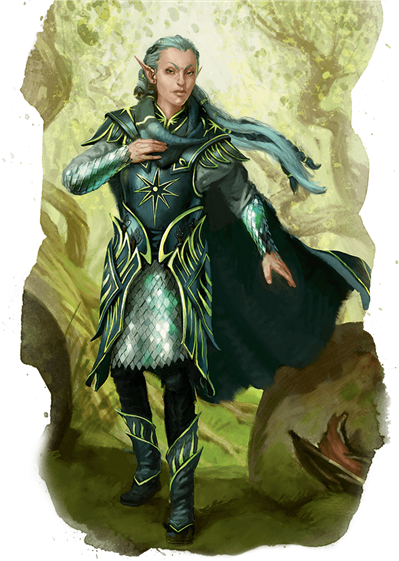 Class is back in session. This week, we extend our hand to the primeval forest and the Sylvan beings that dwell within its ancient roots. There exists a Green Knight—a warden of the elder world—who lives at the boundaries of the world we know. This knight, and those who walk the same fey path, swear the Oath of the Ancients, granting them the power to kindle and protect the light that first gave life to the world. As a paladin who upholds the Oath of the Ancients, it is your duty to see the progenitor light in all beings, and to defeat those who would snuff it out.
Class is back in session. This week, we extend our hand to the primeval forest and the Sylvan beings that dwell within its ancient roots. There exists a Green Knight—a warden of the elder world—who lives at the boundaries of the world we know. This knight, and those who walk the same fey path, swear the Oath of the Ancients, granting them the power to kindle and protect the light that first gave life to the world. As a paladin who upholds the Oath of the Ancients, it is your duty to see the progenitor light in all beings, and to defeat those who would snuff it out.
We’ve completed our first full rotation of the twelve classes, and exhausted all the content that the Basic Rules have to offer—as far as classes go, that is. This next wave of the Class 101 series will appraise every subclass within the Player’s Handbook and break down each subclass’s strengths, weaknesses, thematic elements, and everything else a player would want to know before playing that subclass. Because of this, you will need to own the Player’s Handbook (or purchase the subclass a la carte on the Marketplace) in order to make full use of this series.
Check out other articles in the Paladin 101 series, like our broad overview in Paladin 101: A Beginner’s Guide to Divine Justice, and Paladin 101: Oath of Devotion. If you’re interested in playing other classes, check out the entire Class 101 series.
Story of the Oath of the Ancients
“None shall pass. The heart of the forest is forbidden to you, traveler.”
A knight in armor that once gleamed enamel-white stood atop a hill in the midst of the trackless woods. The knight’s armor was covered in moss and lichen, like a century-old birch, and their helmet bore a magnificent rack of antlers. The helmet had two tapered eyes, and a slender, V-shaped slit that gave the helmet the appearance of a barn owl. A green cloak with a faded pattern of oak leaves sat heavily upon the knight’s shoulders as they gazed down.
A traveler in the forest looked up at the knight, squinting past rays of sunlight that filtered through the trees around the impassive warden. The traveler spoke, lowering the hood of her cloak as she did so. “I fear that I must pass, knight. I beg you not to try and stop me.”
Something in her tone took the knight aback. Appraising the traveler with a mixture of interest and suspicion, the knight inclined their head and allowed their helmet to fall into their hands. Beneath the helmet was the smooth face and short-cropped hair of an elf. “I have been the warden of this wood since I was old enough to carry a spear,” said the knight. “As did my parents, and their parents, ever since both the trees and my bloodline were first blessed by Corellon. Tell me: why should I now, after untold centuries of stewardship, allow a human to enter?”
The traveler looked at the knight, and the knight saw a spark of magic flare within her silver eyes. “I have foreseen death spilling forth from the heart of your forest, knight.” Her lips tapered into a quizzical frown. “Have you not felt it?”
The knight stared at the flash of silver in the traveler’s eyes. “I am a warrior and a protector, not a seer.”
“Then I would not pass into the forest’s heart alone,” said the traveler. “Come with me. If you are a protector, then protect your home from within.”
The knight smiled, and drew their spear and shield from their back. “If you have sight beyond mine, then lead the way. You need not fear while I am at your side.”
Oath of the Ancients Features
The paladin gains access to four subclass features at 3rd, 7th, 15th, and 20th level. You can read all of the Oath of the Ancients features in the Player’s Handbook. In summary, your subclass features allow you to:
- Channel your oath’s divine power to ensnare your foe, or to turn fey and fiendish creatures from your presence.
- Gain permanent access to spells that define your oath.
- Project an aura of warding that shields your allies from destructive magic.
- Survive blows that would otherwise kill you. Additionally, you no longer suffer the effects of old age.
- Transform into an avatar of primeval nature.
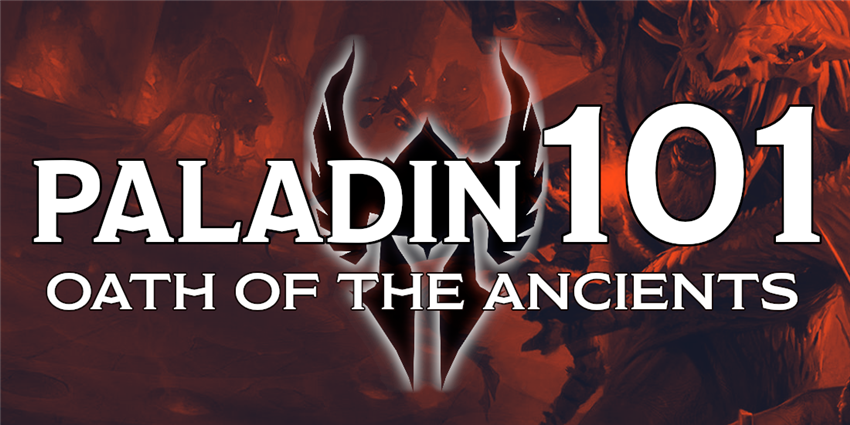
Benefits of the Oath of the Ancients
One of the first benefits a paladin gains from swearing the Oath of the Ancients is their immediate access to spells from outside their class’s typical arsenal. Your Oath Spells feature grants you access to a number of spells from the druid spell list, many of which are focused on the Exploration and Interaction pillars of the game. This is perfect for you, since your ability convert your spell slots into damage through your Divine Smite feature means that picking up a few extra non-combat tricks doesn’t cost you any raw power in combat.
In addition to your already-potent offensive abilities, the Oath of the Ancients grants you a number of incredibly powerful defensive features, too. Aura of Warding grants you and nearby allies resistance to all damage from spells, regardless of damage type. (This is an almost wholly unique power, too. The archmage NPC and the wizard's School of Abjuration subclass are the only other instances in fifth edition of a creature having resistance to damage from spells.) Likewise, Undying Sentinel gives you the barbarian-like ability to shrug off a mortal blow, and your 20th-level Elder Champion transformation gives you self-healing—to say nothing of the offensive power it grants, like faster casting, and imposing disadvantage on saving throws made to resist your spells and Channel Divinity.
Drawbacks of the Oath of the Ancients
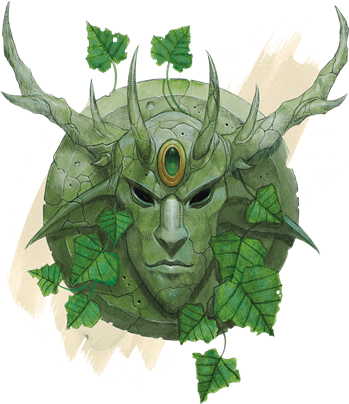 The Oath of the Ancients is a powerful subclass, but it’s not without its drawbacks. Though the subclass grants Domain Spells that can make your life easier while exploring the wilderness, you don’t have any unique options to use in social situations—other than your Charisma score, which is useful to keep as your second- or third-highest ability score. Gaining access to speak with animals and commune with nature grant you a unique bit of druid-like social interaction power, but just like a druid, you’re not so great at talking to people. This is perfectly fitting with the subclass’s archetype—a stoic warden of the ancient wood—but consider asking your DM to include ways for your non-humanoid social abilities to shine.
The Oath of the Ancients is a powerful subclass, but it’s not without its drawbacks. Though the subclass grants Domain Spells that can make your life easier while exploring the wilderness, you don’t have any unique options to use in social situations—other than your Charisma score, which is useful to keep as your second- or third-highest ability score. Gaining access to speak with animals and commune with nature grant you a unique bit of druid-like social interaction power, but just like a druid, you’re not so great at talking to people. This is perfectly fitting with the subclass’s archetype—a stoic warden of the ancient wood—but consider asking your DM to include ways for your non-humanoid social abilities to shine.
Beyond this limitation, the Oath of the Ancient doesn’t have any individual class features that fall flat. Every single one of the subclass’s features are either mechanically powerful or narratively compelling—or both!
Suggested Build
If you’re building an Oath of the Ancients paladin from 1st level, be aware that you won’t gain your subclass until 3rd level. When creating your character, you should choose a race that gives you a bonus to Strength, Constitution, or Charisma—ideally at least two of the three. For this reason, dragonborn make excellent offense-focused paladins, thanks to their bonus to both Strength and Charisma. Half-elves likewise make good paladins, as do half-orcs and humans. From a thematic perspective, elves, half-elves, humans, and half-orcs all have strong ties to the natural world, and are an obvious choice for an Oath of the Ancients paladin.
While all paladins are well-suited towards wearing heavy armor and using powerful, Strength-based weapons, you can also forgo heavy armor and use finesse weapons instead by prioritizing your Dexterity score instead of your Strength score. Dexterity-focused paladins are fairly uncommon, especially compared to Dexterity-based fighters and rangers, since their powerful Divine Smite ability can't be activated with ranged attacks—only melee weapon attacks. If you want to be an offensive striker, make Strength or Dexterity your highest ability score. If you want to be a tanky defender, place your highest ability score in Constitution. Charisma should always be your second- or third-highest score. It’s important, but you’re a warrior first and a spellcaster second.
As usual, your character’s background is up to you. Paladins are often acolytes who have received martial training, or soldiers who have found a sacred calling, but paladins from other backgrounds can make for exciting unlikely heroes. The Outlander or Hermit backgrounds are exceptionally well-suited to the flavor of your subclass, as a warden of the primeval world.
Select EQUIPMENT when creating a character. You should probably choose a martial weapon and a shield, even if you’re a Dexterity-based paladin—for reasons that will be explained below. If you’re playing a Strength-based paladin, you can’t go wrong with an iconic longsword and shield, and a Dexterity-based paladin can use a rapier and a shield in tandem. Choosing five javelins is your best bet, since you’ll want a way to fight from range.
Fighting Style
At 2nd level, you can choose a Fighting Style. You have four choices, each of which makes you slightly better in a certain type of combat role, but doesn’t preclude you from using alternative tactics. The Defense style is a good, passive buff; you gain +1 AC while in armor. Great for surviving, but not very proactive. The Dueling style is great if you fight with a one-handed weapon, and improves your damage even if the other hand is using a shield. Great Weapon Fighting is useful if you like to fight with two-handed weapons, and can improve your damage even if you’re wielding a one-handed versatile weapon —like a longsword—in both hands. Finally, the Protection style helps make you a formidable tank, allowing you to deflect incoming blows if you stand next to your allies.
Notably, the Archery and Two-Weapon Fighting styles are absent from this list, though they’re both usable by fighters and rangers. Consider asking your Dungeon Master if you can use one of these styles if you’re playing a Dexterity-based paladin. These options aren’t game-breaking, so as long as you’re playing in a campaign where strict adherence to the rules isn’t required (such as in D&D Adventurers League games), I highly recommend that your DM allow house ruling these fighting styles into the paladin class.
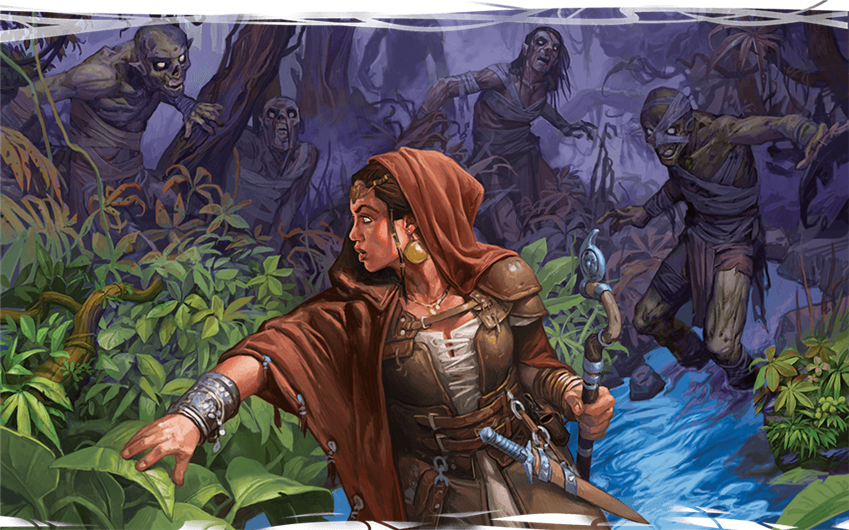
Spells
The paladin also gains access to spells at 2nd level, drawing from their own unique spell list. While your spell selection is more limited and you gain access to more powerful spells more slowly than “full caster” classes, you balance it out with your robust combat arsenal. Take this time before you gain your subclass at 3rd level to feel out what your role in the party is. That way, when you do gain your subclass (as well as the host of permanently prepared Oath Spells that come with it), you’ll know what spells your party needs you to have access to on a regular basis.
Fortunately, you can choose a different set of spells at the start of each new day, just like a cleric. The entire paladin spell list is available to you, so you can adapt your spell selection to whatever challenges you think you’ll be facing. Either way, choosing a “standard loadout” of spells that you can rely upon on an average adventuring day is useful. You can prepare a number of paladin spells equal to half your level (rounded down) plus your Charisma modifier. So, if you’re a 2nd-level paladin with a Charisma score of 14 (+2), you can prepare three spells from the paladin spell list. To give yourself a well-balanced loudout, choose one spell labeled OFFENSE, one labeled DEFENSE, and one labeled SUPPORT. Note that this list only includes some spells from the Player's Handbook, so if you want to choose more unusual spells, or have other sources like Xanathar's Guide to Everything, you'll have to do a little self-directed research. This list is just here to get you started if this is your first time playing an Oath of the Ancients paladin.
- Bless (SUPPORT)
- Compelled duel (DEFENSE)
- Cure wounds (SUPPORT)
- Divine favor (OFFENSE)
- Shield of faith (DEFENSE)
- Thunderous smite (OFFENSE)
- Wrathful smite (OFFENSE)
Feats
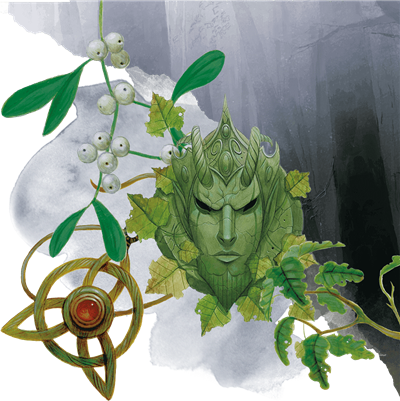 At 4th level, you get to gain either an Ability Score Increase or a feat. Choosing an Ability Score Increase lets you increase one ability score by +2 (such as increasing your Wisdom score from 16 to 18) or increase two ability scores by +1 (like increasing your Strength from 15 to 16 and your Charisma score from 13 to 14). Increasing your ability scores makes you better at a wide variety of things; for instance, increasing your Charisma score makes it harder for enemies to resist your spells, and also makes you better at making Charisma checks.
At 4th level, you get to gain either an Ability Score Increase or a feat. Choosing an Ability Score Increase lets you increase one ability score by +2 (such as increasing your Wisdom score from 16 to 18) or increase two ability scores by +1 (like increasing your Strength from 15 to 16 and your Charisma score from 13 to 14). Increasing your ability scores makes you better at a wide variety of things; for instance, increasing your Charisma score makes it harder for enemies to resist your spells, and also makes you better at making Charisma checks.
Feats, on the other hand, give you a special ability that could be more helpful in a specific circumstance, as opposed to the broad improvement that an Ability Score Increase could give you. Strength, Constitution, and Charisma are your most important ability scores, since they govern your offensive, defensive, and spellcasting abilities. Since you have several ability scores to pour Ability Score Increases into, you may only want to only choose a feat if it seriously speaks to you. You can choose any feat you want to support your character concept, but there are some feats that may be more useful to your character than others. These feats include:
Great Weapon Master. If you wield a big weapon and want to deal massive damage, this is your go-to. It’s less vital to you than a fighter, however, since you have Divine Smite for burst damage. You would generally rather hit so you can activate your smites than gamble on a bit of extra damage. Nevertheless, it’s still a good option.
Inspiring Leader. This is a thematically appropriate choice for a paladin, and it fits your role as a warrior who always has your party’s back.
Polearm Master. You don’t typically use your bonus action for anything except for spells like wrathful smite, so being able to turn it into another attack (and thus, another chance to use your Divine Smite, which doesn’t cost an action to activate) is very attractive.
Resilient (Constitution). Like War Caster (below), this feat makes it harder to lose concentration on your spells by granting you proficiency in Constitution saving throws—while also improving your Constitution score by +1. Its bonus to making saves to maintain concentration isn’t as good as advantage (at low levels), but it gives a broader spectrum of bonuses.
Shield Master. Paladins love fighting with a sword in one hand and a shield in the other, so amping up your shield-using skills makes sense.
War Caster. This feat suits the paladin playstyle perfectly by making it harder for your concentration to be broken in the heat of battle. Since paladins only gain a few precious spell slots, concentration spells are a good way to stretch their magic as far as possible—so it feels terrible when you cast a concentration spell, only to be hit by a goblin or two next round and lose your concentration from some meager damage.
If you want more advice for building a paladin, check out Paladin 101. Have you ever played an Oath of the Ancients paladin? What advice would you give to players that want to play this subclass?
 James Haeck is the lead writer for D&D Beyond, the co-author of Waterdeep: Dragon Heist, Baldur's Gate: Descent into Avernus, and the Critical Role Tal'Dorei Campaign Setting, a member of the Guild Adepts, and a freelance writer for Wizards of the Coast, the D&D Adventurers League, and other RPG companies. He lives in Seattle, Washington with his fiancée Hannah and their animal companions Mei and Marzipan. You can find him wasting time on Twitter at @jamesjhaeck.
James Haeck is the lead writer for D&D Beyond, the co-author of Waterdeep: Dragon Heist, Baldur's Gate: Descent into Avernus, and the Critical Role Tal'Dorei Campaign Setting, a member of the Guild Adepts, and a freelance writer for Wizards of the Coast, the D&D Adventurers League, and other RPG companies. He lives in Seattle, Washington with his fiancée Hannah and their animal companions Mei and Marzipan. You can find him wasting time on Twitter at @jamesjhaeck.








-
View User Profile
-
Send Message
Posted Nov 15, 2019while i normally play druid, this is a very appealing alternative
-
View User Profile
-
Send Message
Posted Nov 15, 2019Appreciate the mention of Dexadins!
This is one of my favourite, if not the most favoured, paladin subclasses. They really conjure a unique image and give rise to unusual concepts that no other subclass, or really, class, could emulate. Great introduction to it for players new and seasoned!
-
View User Profile
-
Send Message
Posted Nov 15, 2019Who needs dex when you're resistant to all the magics?
I'll also take the opportunity to implore anyone who reads this to not pick a god next time they play a pally. Actually play the Oath!! Might open up more RP opportunities for you next time :D
-
View User Profile
-
Send Message
Posted Nov 15, 2019The best tank in the game for taking magical damage.
-
View User Profile
-
Send Message
Posted Nov 15, 2019Oath of Ancients Paladin with mounted combatant feat riding their druid team mate wildshaped as a bear.
-
View User Profile
-
Send Message
Posted Nov 15, 2019It pairs well with Yuan-ti Pureblood for being able to completely laugh at spellcasters. Reduced damage from spells, plus advantage on saving throws versus spells, plus adding charisma bonus to saving throws plus a racial +2 to charisma.
-
View User Profile
-
Send Message
Posted Nov 15, 2019I played a firbolg paladin with this oath and it was a blast!
-
View User Profile
-
Send Message
Posted Nov 15, 2019I've never been really interested in the Oath of the Ancients Paladin, but being described as a warden sounds cool, and I might play one for my next character.
-
View User Profile
-
Send Message
Posted Nov 15, 2019Another great article!
-
View User Profile
-
Send Message
Posted Nov 15, 2019One of my favorite characters was a halfling dex based paladin. He rode everywhere on his little war dog.
-
View User Profile
-
Send Message
Posted Nov 16, 2019i still miss the warden paladin from the playtest although not as much as being a drunk wizard with the magic missle cantrip
-
View User Profile
-
Send Message
Posted Nov 16, 2019my favorite paladin character was sworn to the Ancients. This is a very cool Oath!
-
View User Profile
-
Send Message
Posted Nov 16, 2019Great article!! Playing a 5th level Paladin Oath of the Ancients. Link.
Having a lot of fun. This oath is said to be one of the best tank builds, and it hasn’t disappointed me so far. My group graciously got me some plate and with Shield of Faith the character is pretty much un-hittable now. I chose this oath for the theme and I am having a blast RPing the character too.
-
View User Profile
-
Send Message
Posted Nov 16, 2019I'd say that given how limited a resource Feats/ASI can be, I'd suggest forgoing Resilient (Con) and maaaybe War Caster in favor of ASI (Cha). The reason being that paladins may add their Cha mod to all saving throws. The advantage mechanic is nothing to sneeze at, but most pally combat spells are verbal-only, so they don't interfere with a great weapon or sword-and-board warrior.
-
View User Profile
-
Send Message
Posted Nov 16, 2019Why are there no links for the feats?
Other than that this is a great article! I have an AL OotA Duergar Paladin and she’s awesome.
-
View User Profile
-
Send Message
Posted Nov 16, 2019Take a 1 level splash of Hexblade for the ability to attack with Charisma, and you've got one of the best munchkin builds in the game.
-
View User Profile
-
Send Message
Posted Nov 16, 2019Draygon Firebrand Copper Dragonborn with the Dragon Hide feat and the Great Weapon Master feat along with a Ring of Protection and Cloak of Protection time to kill some bad guys 😁
-
View User Profile
-
Send Message
Posted Nov 16, 2019Really wish that spear could be a finesse weapon, so you could make a polearm master dexadin. I guess the main problem is it would be to strong on rogues.
-
View User Profile
-
Send Message
Posted Nov 16, 2019Does anyone know if they're going to be releasaing the stats for the sapphire dragon from the dice set on D&D beyond, or do you have to buy the couple of hundred dollar dice to get it?
-
View User Profile
-
Send Message
Posted Nov 16, 2019Paladin's are a bit OP. I did Waterdeep: Dragon Heist with my cousin who was playing a paladin. They got to level 2 and went to the Xanathar Guild base, easily killed everyone in the dungeon, got to the last room in the dungeon with the half orc apprentice wizard, the intellect devourer, and the mind flayer Nihiloor. The mind flayer was supposed to teleport away, but he didn't have time. He had around 70 hit points, and was surprised, so the rogue threw a couple of sneak attack daggers at him, got him to around 50 hit points, and the paladin came in on the second round and got a natural 20 to hit with a greatsword, used a divine smite, and rolled a lot of damage with great weapon master (he was a variant human that took great weapon master at level 1), I'm not sure how much he did, but it was around 65 damage, and he killed the mind flayer in one hit. They then easily defeated the other two creatures, rescued Floon, and went on their way.
The character then went on to become an Oath of Conquest paladin, and went into Undermountain, completely wrecking everything, and getting too high level way faster than I thought. He went on to kill Xanathar and blow up his base. We're almost done with Waterdeep: Dungeon of the Mad Mage, which we both really like, and he's level 16.
Anyone else think paladin's are OP, reply if you have a story like this.